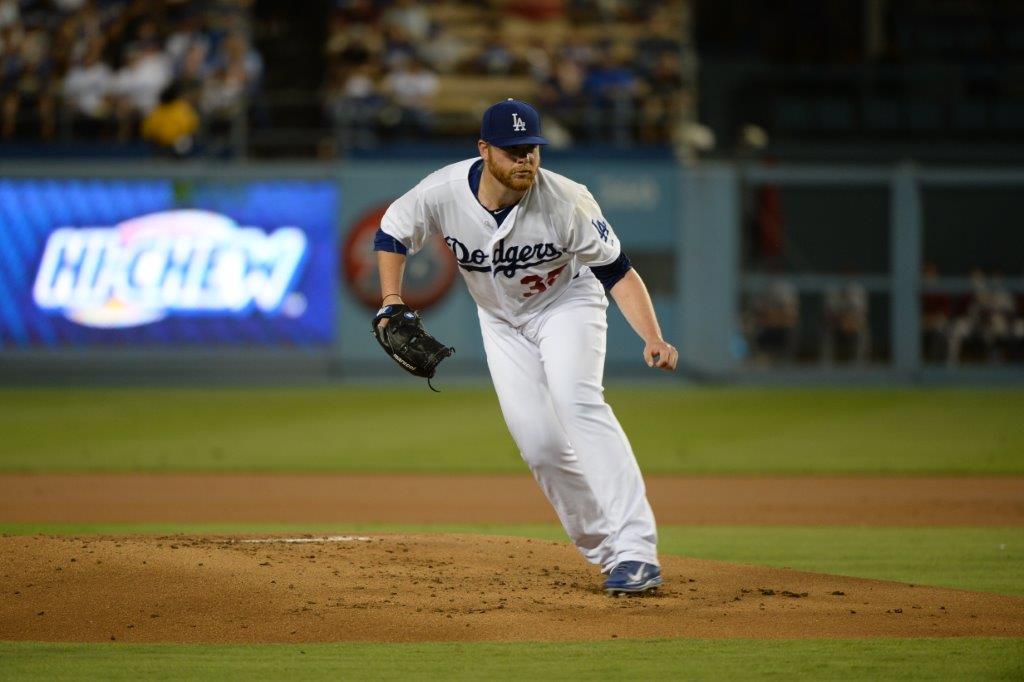By Jon Weisman
Brett Anderson sat in the chair in front of his locker this morning, his beard a bit longer than it was last year, his outlook a bit more relaxed.
Anderson won’t deny he was tiring by the end of 2015. His 3.69 ERA in a career-high 180 1/3 innings was a physical triumph for a pitcher who had been limited by injuries to 123 innings over the previous three seasons. But that came with a ton of energy dedicated to just making it to the finish line.
Health, or the lack thereof, has been the prologue to practically every Brett Anderson story for years. The big ones — Tommy John surgery and a bulging disc in his back — made the most ambles into the preamble. It was always something, but maybe that’s about to change.
Following last year’s success, Anderson was able to dedicate his winter more to prehab than rehab. To taking a step forward, as opposed to just hanging on.
“Last offseason was just rehabbing my back and just trying to make sure I could get through 30-plus starts,” Anderson said. “This year, I was able to do some strength stuff and some movement stuff, and hopefully that will translate into being strong for 30-plus starts, rather than just getting my body through 30-plus starts.”
It’s almost hard to believe, but Anderson is still only 28 years old. He has definitely been through the wars, emerging as something of a different pitcher than he used to be. In 2015, he led the Majors — by a wide margin — in groundball percentage, recording 66.3 percent of his outs off the dirt.
In a word, Anderson thought that was “weird.”
Anderson isn’t ashamed of those grounders, but he would welcome even a little resurgence in whiffs. In his abbreviated 2013 season (44 2/3 innings), he struck out 9.3 batters per nine innings. His career average is 6.7.
“If I could get some strength, get some velocity back, maybe that’ll translate into some more strikeouts and being able to put guys away,” Anderson said. “Just some of those things — get my slider back to where I feel comfortable, get some swings and misses. My bullpens in camp have been good, and facing hitters for the first time today, it’ll be good to get some swings and see some recognition and get ready for games.
“I’ve been a groundball guy before, but last year it seemed like there was 20 a game almost. Me being the non-athlete that I am, hopefully I can get some strikeouts so I can field my position a little less. If not, I know I can have some success with the way I did it last year.”
Anderson would also be happy to whittle down the 18 homers he allowed in 2015, which doesn’t really fit with the groundball profile.
“Hopefully, it’s kind of one of those anomalies or fluky things, where it seemed like every fly ball, especially in the second half of the season, turned into a homer,” Anderson said. “But my hard-hit balls (rate) was really low. If I could limit the damage of the fly balls that I do give up, and then hopefully get some more strikeouts and keep up the trend of the groundballs, then good things’ll happen.”
Anderson didn’t need to look back far for motivation. What was probably his worst start of 2015 took place at the worst possible time — in Game 3 of the National League Division Series.
“I just got hit,” Anderson said. “It wasn’t like I was walking people and all over the place. There were a couple of bad pitches, there was some choppers that got beat out. Next thing you know (Curtis) Granderson hits — it’s a fairly good pitch, but he just did a good job of hitting.”
Granderson’s two-out, second-inning, bases-clearing double gave the Mets a 4-3 lead. In the next inning, again with two outs, Travis d’Arnaud hit a two-run homer off a pitch that Anderson truly regretted.
“So that kind of puts a chip on my shoulder,” Anderson said. “It was not a good time to have a bad outing, but hopefully I make amends for it this year.”
Which makes it nice that physically, things could be lining up in his favor.
“The back injury was a little bit more of an unknown,” Anderson said, “just because it’s a disc and and back stuff’s kind of scary, and pitching’s such a core and rotational thing — I didn’t know how it was going to hold up. But thankfully it did, and there’s no issues going forward.
“I feel more confident in my body being able to hold up than I did at this point last year. That’s always good to have in the back of your mind, where you have no issues, and just do the work and do the prehab and try to be proactive — and (then) good things happen.”





Comments are closed.